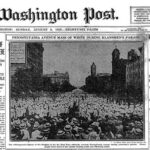
Is the Media Fear-Mongering About the NIH? Examining the Controversy
Tháng 4 10, 2025EU and China: Pioneering a New Era in Electric Vehicle Trade Negotiations
Tháng 4 10, 2025Recent Developments in President Trump’s Trade Team: Strategic Shifts and Internal Dynamics
The landscape of international trade is ever-evolving, and recent developments within President Donald Trump’s trade team are a testament to the administration’s recalibrated approach. Significant changes have taken place, reflecting not only strategic shifts but also the internal power dynamics that play a crucial role in the administration’s economic policies.
Reshuffle of the Trade Team: A New Direction
One of the most notable developments has been the reshuffle of key personnel within the trade team. Scott Bessent, a former hedge fund manager, has stepped into a prominent position focused on managing trade efforts. His appointment comes at a critical juncture for the administration, particularly as it grapples with troubled financial markets. Bessent’s approach is part of a broader pivot towards “fair trade” principles, which aim to create a more balanced playing field in international commerce. This strategic shift signals a responsiveness to the changing economic climate and the need for more equitable trade practices that align with American interests.
The Evolving Roles of Lutnick and Navarro
Alongside Bessent’s ascendancy, the roles of key figures Howard Lutnick and Peter Navarro have also seen significant transformation. Lutnick, once a central player in trade negotiations, has experienced a diminishment of his influence. However, he has taken on the role of a “bad cop” in negotiations. This approach plays to his strengths, utilizing a confrontational demeanor that may serve the administration’s bargaining strategies by applying pressure on negotiating counterparts.
Meanwhile, Peter Navarro, known for his populist economic views, continues to advise Trump on trade matters. However, his presence in current discussions appears to be more subdued than before. This reduced visibility suggests an internal reevaluation of advisor roles within the trade team, wherein decision-making authority may be consolidating around new leadership.
Engaging in Global Trade Efforts
As the Trump administration pivots its strategy, it is also actively engaging with over 50 countries in various trade negotiations. This outreach exemplifies the administration’s commitment to fostering international relationships despite ongoing tensions with specific partners. Recent talks with Japan and South Korea represent a proactive stance in addressing trade disparities and exploring new bilateral agreements. Additionally, plans to negotiate with other critical partners, such as the United Kingdom, India, and Australia, highlight a strategic focus on solidifying U.S. positions in global markets.
Furthermore, the blog discusses China’s recent engagement with global CEOs to address U.S.-China trade tensions, emphasizing the need for international stability and collaboration. It highlights China’s commitment to being a favorable investment destination and the assurance of fair treatment for foreign companies. This is part of China’s strategy to enhance partnerships amidst ongoing tariff challenges, aligning closely with the themes of trade dynamics relevant to President Trump’s trade team developments. Read more here.
Economic Implications Amid Trade Conflict
These developments occur against a backdrop of economic volatility, exacerbated by a protracted trade conflict with China and looming recession risks. Market reactions have been a mixed bag; while there was temporary relief following the announcement of paused tariffs, renewed anxieties about the future of trade relations have surfaced. Investors remain apprehensive as they navigate the complexities of a fluctuating economic environment that could have far-reaching implications for both domestic and global markets.
In conclusion, the recent developments within President Trump’s trade team illustrate a dynamic interplay of strategic realignment, personnel changes, and broader economic implications. As the administration grapples with these challenges, the effectiveness of its trade policies will be closely scrutinized in the months to come. The interplay of internal power dynamics and external negotiations will undoubtedly shape the future of U.S. trade relations, underscoring the importance of adaptive strategies in an increasingly interconnected world.
